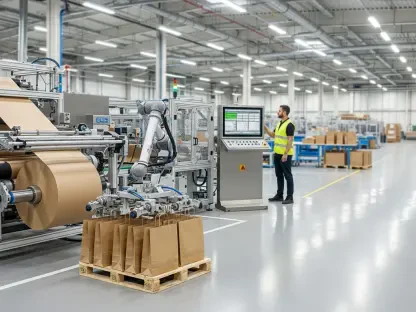What if a single industry could transform a nation’s economic destiny on the world stage? India’s specialty chemicals sector is emerging as a silent powerhouse, shifting from the sidelines of bulk production to a pivotal role in global innovation. With a market projected to surpass $60 billion by 2026, this dynamic field is not just about chemicals—it’s about redefining how industries function, from cutting-edge pharmaceuticals to advanced electronics. This narrative dives into how India is leveraging unique opportunities and overcoming challenges to claim its place among the world’s chemical giants.
The Critical Role of Specialty Chemicals Today
Specialty chemicals are far more than industrial byproducts; they are the hidden engines driving modern advancements across diverse sectors. These high-performance, customized materials enhance the durability of automobiles, improve the efficacy of life-saving drugs, and even elevate the quality of everyday consumer goods. As global demand for such tailored solutions skyrockets, with the market expected to exceed $900 billion by 2028, India finds itself at a crucial crossroads to meet both domestic urbanization-driven needs and international calls for supply chain alternatives.
This surge in relevance isn’t merely a trend but a structural shift in how industries prioritize value over volume. For a country long associated with cost-effective bulk chemical output, this represents an unprecedented chance to reposition itself as a leader in innovation. The stakes are high, as success in this arena could redefine India’s industrial identity and economic influence globally.
Foundations of India’s Climb in the Chemical Sector
Several key elements underpin India’s growing prominence in the specialty chemicals market, each revealing a facet of its potential to dominate globally. A primary factor is the strategic pivot from bulk commodities to specialized products, impacting industries like agriculture with advanced agrochemicals and technology with sophisticated electronic materials. This transition signals a commitment to precision and high-value output over sheer quantity.
Global geopolitical shifts further bolster this ascent, particularly the “China-plus-one” strategy, where buyers seek alternatives due to China’s environmental production cutbacks. India, holding a 4% share of the global market against China’s 26%, stands poised to capture significant growth through agility and reliability. Domestically, a young, aspirational consumer base with rising incomes fuels demand for premium, customized products, creating a robust internal market.
Government support also plays a vital role, with initiatives like the Production-Linked Incentive (PLI) schemes and Petroleum, Chemicals, and Petrochemicals Investment Regions (PCPIRs) providing a structural backbone. Yet, challenges such as dependency on imported raw materials persist, highlighting the need for strategic solutions. These combined factors illustrate a nation on the cusp of a chemical revolution, balancing opportunity with complexity.
Industry Leaders Weigh In on the Transformation
Insights from industry experts lend depth to this unfolding story, grounding optimism in real-world perspectives. Anil H. Gupta, a prominent figure in the sector, describes India as standing at an “inflection point” to seize global growth opportunities. He emphasizes that scaling the value chain requires a relentless focus on innovation and sustainability to meet international benchmarks.
Beyond expert views, tangible examples of adaptation add credibility to the narrative. Indian firms are increasingly aligning with global standards, adopting advanced manufacturing processes to compete in high-stakes markets like pharmaceuticals and coatings. Market projections estimating a leap to $60 billion by 2026 reinforce this momentum, painting a picture of an industry not just participating but actively shaping global trends.
These voices and developments collectively highlight a sector in transition, where ambition meets action. The blend of strategic foresight and on-the-ground efforts suggests that India’s chemical industry is not merely reacting to change but driving it with purpose.
Navigating Challenges to Secure a Leading Position
Despite the promise, significant hurdles remain on the path to global leadership in specialty chemicals. Infrastructure gaps and reliance on imported raw materials, such as critical hydrocarbons, expose vulnerabilities that could slow progress if unaddressed. Developing domestic production capabilities or forging strategic international alliances could mitigate these risks, ensuring a steadier supply chain.
Moreover, aligning with global environmental expectations is no longer optional but essential. Embracing green chemistry and circular economy practices can position Indian companies to command premium pricing while meeting stringent sustainability standards. Such measures also resonate with a growing consumer preference for eco-friendly solutions, adding a competitive edge in international markets.
Policy frameworks must evolve to streamline approvals and bolster cluster-based manufacturing, reducing bureaucratic delays that hinder growth. By tackling these challenges head-on, India can transform potential into sustained impact, ensuring that its specialty chemicals sector becomes synonymous with innovation and reliability on the world stage.
Blueprint for Sustained Global Dominance
To cement its place as a chemical powerhouse, India must adopt a multi-pronged strategy that prioritizes actionable growth. Scaling innovation through increased investment in research and development, alongside partnerships with global firms, can establish the country as a hub for niche products like advanced coatings and electronic chemicals. Creating intellectual property in these high-growth areas is a specific target that could yield long-term dividends.
Additionally, addressing systemic issues through enhanced infrastructure and reduced import dependency is critical for resilience. Simultaneously, leveraging policy support, such as the National Chemical Policy, to foster a conducive business environment will accelerate progress. These steps, combined with a commitment to sustainable practices, outline a roadmap for stakeholders to ensure lasting influence in the global arena.
Looking back, India’s journey in the specialty chemicals sector has been marked by a remarkable shift from bulk production to high-value innovation, driven by both domestic strengths and global opportunities. Reflecting on this trajectory, the path ahead demands a focus on building robust R&D ecosystems to pioneer cutting-edge solutions. Strengthening supply chain independence has proven vital, as has aligning with sustainability goals to meet evolving market expectations. The challenge now lies in maintaining this momentum, ensuring that every stakeholder—from policymakers to industry leaders—collaborates to turn ambition into enduring global leadership.









